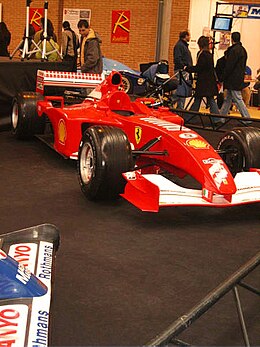Ferrari F2001
 |
|||||||||||
| Category | Formula One | ||||||||||
|---|---|---|---|---|---|---|---|---|---|---|---|
| Constructor | Ferrari | ||||||||||
| Designer(s) | Rory Byrne | ||||||||||
| Predecessor | F1-2000 | ||||||||||
| Successor | F2002 | ||||||||||
| Technical specifications | |||||||||||
| Chassis | Moulded carbon fibre & Honeycomb composite structure | ||||||||||
| Suspension (front) | Independent suspension, pushrod activated torsion springs | ||||||||||
| Suspension (rear) | Independent suspension, pushrod activated torsion springs | ||||||||||
| Length | 4,460 mm (176 in) | ||||||||||
| Width | 1,800 mm (71 in) | ||||||||||
| Height | 1,100 mm (43 in) | ||||||||||
| Engine | Ferrari Tipo 050 , 3.0 L (3,000 cc; 183 cu in) , V10 (90°) @ 18,500 RPM , Naturally Aspirated , in a mid-mounted, rear-wheel drive layout | ||||||||||
| Transmission | Semi-automatic Sequential Limited-slip Differential Gearbox Seven Speed Forward + One reverse | ||||||||||
| Power | 800–900 horsepower (600–670 kW) @ 18,500 RPM | ||||||||||
| Weight | 600 kg (1,323 lb) | ||||||||||
| Fuel | Shell Fuel | ||||||||||
| Lubricants | Shell Lubricant | ||||||||||
| Brakes | Carbon brake discs, pads and calipers | ||||||||||
| Tyres | Bridgestone BBS Racing Wheels : 13" | ||||||||||
| Competition history | |||||||||||
| Notable entrants | Scuderia Ferrari Marlboro | ||||||||||
| Notable drivers | 1. 2. |
||||||||||
| Debut | 2001 Australian Grand Prix | ||||||||||
|
|||||||||||
| Constructors' Championships | 2001, 2002 | ||||||||||
| Drivers' Championships | 2001, 2002 | ||||||||||
The Ferrari F2001 was a highly successful Formula One car, designed by Ross Brawn and Rory Byrne for the 2001 Formula One season. A revised version known as the F2001B was used in the first two races of 2002 before being replaced by the F2002.
The F2001 was designed around new regulation changes which mandated a higher-mounted front wing assembly to reduce downforce. This resulted in a distinctive 'droopsnoot' nose section and spoon-shaped front wing. The season also saw the re-introduction of traction and launch control systems, therefore the car and its suspension were designed with this in mind.
Being somewhat of a departure over previous Brawn/Byrne Ferrari designs, the car was based more on McLaren's design thinking. However, the car did feature Ferrari trademarks, such as the periscope exhausts pioneered by the team in 1998 and the small bargeboards which were a feature of its predecessors. The F2001 used the same basic gearbox and internal layout as its predecessors, however the aerodynamic efficiency and tyre wear were improved considerably over the F300 (1998), F399 (1999) and F1-2000 (2000).
Setting up the car proved easier, and it was faster than the rival McLaren MP4-16, but the Williams FW23—although aerodynamically inferior—was fitted with the massively powerful BMW engine, which was more than a match for the Ferrari power unit.
...
Wikipedia
